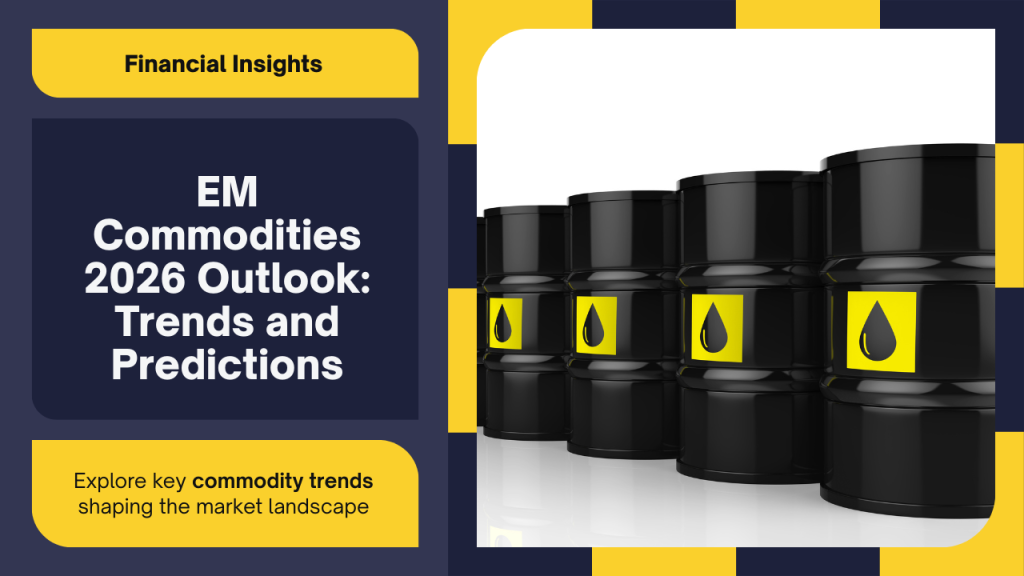
Entering 2026: Commodities at a Turning Point
As 2026 begins, global commodities are at a structural turning point. The supercycle narrative — driven by energy transition, infrastructure investment, and supply chain realignment — is colliding with cyclical headwinds such as moderating global growth and potential policy uncertainty.
For Emerging Markets (EM), commodities are both a growth engine and a risk factor. Exporters like Brazil, Indonesia, Chile, and South Africa are heavily influenced by demand from China, India, and developed markets. Meanwhile, EM consumers face imported inflation risks from volatile commodity prices.
Macro Backdrop for Commodities in 2026
Demand Drivers
- Energy Transition: Ongoing demand for copper, lithium, and nickel.
- Industrial Recovery: India, Vietnam, and Mexico driving industrial metals demand.
- Food Security: Climate events continue to pressure agricultural supply.
Supply Constraints
- Geopolitics: OPEC+ oil supply decisions, Russia/Ukraine conflict, Middle East instability.
- Mining Capex Gaps: Years of underinvestment in copper and nickel supply.
- Climate Shocks: Extreme weather disrupting harvests and logistics.
Energy Outlook
Oil & Gas
- Prices expected to stabilize in $75–85/bbl range.
- OPEC+ continues supply management.
- U.S. shale growth moderates, shifting balance toward EM producers (Saudi Arabia, Nigeria, Brazil).
LNG
- Demand grows in Asia (India, Vietnam, Philippines).
- Qatar, U.S., and Mozambique expand supply.
- EM buyers diversify import sources to reduce dependence.
Metals Outlook
Copper
- Demand fueled by EVs, renewable energy, and grid upgrades.
- Chile and Peru remain dominant, but political risks linger.
Lithium & Nickel
- Indonesia, Australia, Chile lead supply.
- Strong demand from Korea, China, and Europe for EV batteries.
Gold
- Safe-haven demand remains high amid geopolitical risks.
- EM central banks continue gold purchases for reserve diversification.
Agriculture Outlook
Grains & Oilseeds
- Brazil, Argentina, and U.S. remain key suppliers.
- India and Africa face rising demand for imports.
Soft Commodities (Coffee, Sugar, Cocoa)
- Brazil and Vietnam dominate supply.
- Weather volatility will drive short-term price shocks.
Food Security
- Climate change and El Niño events push governments to secure stable supplies.
Interim Insights (Mid-2026 View)
- Commodities remain strategic allocations in portfolios.
- Energy transition metals (copper, lithium, nickel) are structural winners.
- Agriculture will remain volatile but essential for inflation hedging.
- Oil stabilizes, but geopolitical shocks could cause temporary spikes.
Risk Scenarios for Commodities in 2026
- China Slowdown
- Lower industrial demand would hit copper, nickel, and oil exporters.
- Geopolitical Disruptions
- Escalations in the Middle East or Eastern Europe could spike oil/gas prices.
- Climate Shocks
- Extreme weather disrupts agricultural production (coffee, soy, wheat).
- Policy Shifts
- Carbon taxes, mining restrictions, and ESG regulations could tighten supply.
Investment Strategy Recommendations
Energy
- Maintain balanced exposure through ETFs and futures.
- EM oil exporters (Brazil, Saudi Arabia) remain key equities for investors.
Metals
- Overweight copper and lithium as structural plays.
- Selective equity opportunities in Chile, Peru, and Indonesia miners.
Agriculture
- Use commodity ETFs for diversification.
- Tactical exposure to soft commodities during climate disruptions.
Gold & Precious Metals
- Strategic allocation as hedge against geopolitical risks and USD volatility.
- Central bank demand underpins long-term value.
Portfolio Construction Ideas
- Balanced EM Commodity Portfolio (2026)
- 35% Metals (Copper, Lithium, Nickel)
- 30% Energy (Oil, LNG, Gas)
- 20% Agriculture (Grains, Soft Commodities)
- 15% Gold & Precious Metals
- Tactical Opportunities
- Long gold during geopolitical stress.
- Long agricultural ETFs during El Niño cycles.
- Overweight copper/lithium miners tied to EV transition.
Key Takeaways for 2026 Commodities
Commodities remain at the heart of EM investment strategies in 2026. Structural demand from the energy transition ensures long-term growth in metals, while oil stabilizes at moderate levels. Agriculture will remain volatile but increasingly critical for global food security. Gold continues as a strategic hedge.
For investors, commodities in 2026 are not just tactical trades but structural allocations in diversified EM portfolios.
Leave a Reply